Complete Solutions to physics of chapter WORK, ENERGY AND POWER of Class 12 book with complete answers and questions
| Class 12 | PHYSICS |
| Chapter | WORK, ENERGY AND POWER |
| DISHA | physics |
| Number Of Questions | 56 |
| Academic Year | 2023-24 |
A body is acted upon by a force `vec(F)=-hati+2hatj+3hatk`. The work done by the force in displacing it from (0,0,0) to (0,0,4m) will be -
02:20View SolutionThe work done in pulling a body of mass 5 kg along an inclined plane (angle `60^(@)`) with coefficient of friction 0.2 through 2 m, will be -
03:59View SolutionA force`vecF=(7-2x+3x^(2))` N is applied on a 2 kg mass which displaces it from x = 0 to x = 5 m. Work done in joule is -
02:10View SolutionAn automobile of mass m accelerates from rest. If the engine supplies a constant power P, the velocity at time t is given by -
02:53View SolutionIn the above question, the position (s) at time (t) is given by -
03:49View SolutionA particle moving in a straight line is acted by a force, which works at a constant rate and changes its velocity from u to v in passing over a distance x. The time taken will be -
04:54View SolutionA chain of linear density 3 kg /m and length 8 m is lying on the table with 4 m of chain hanging from the edge. The work done in lifting the chain on the table will be -
03:07View SolutionThe work done in lifting water from a well of depth 6 m using a bucket of mass 0.5 kg and volume 2 litre, will be-
01:35View SolutionAn object of mass 5 kg falls from rest through a vertical distance of 20 m and reaches a velocity of 10 m/s. How much work is done by the push of the air on the object ? `(g=10m//s^(2)).`
05:00View SolutionA boy pulls a 5 kg block 20 metres along a horizontal sur- face at a constant speed with a force directed 45° above the horizontal. If the coefficient of kinetic friction is 0.20, how much work does the boy do on the block?
05:54View SolutionA uniform chain is held on a frictionless table with one third of its length hanging over the edge. IF the chain has a length l and a mass m, how much work is required to pull the hanging part back on the table ?
03:36View SolutionA bus of mass 1000 kg has an engine which produces a constant power of 50 kW. If the resistance to motion, assumed constant is 1000 N. The maximum speed at which the bus can travel on level road and the acceleration when it is travelling at 25 m/s, will respectively be -
04:41View SolutionThe power output of a`_92U^(235)` reactor if it takes 30 days to use up 2 kg of fuel and if each fission gives 185 MeV of energy (Avogadro number`=6xx10^(23)//mole) will be -
08:59View SolutionThe stopping distance for a vehicle of mass M moving with a speed v along a level road, will be - (µ is the coefficient of friction between tyres and the road)
03:49View SolutionThe earth circles the sun once a year. How much work would have to be done on the earth to bring it to rest relative to the sun, (ignore the rotation of earth about - its own axis) Given that mass of the earth is `6 × 10^(24)` kg and distance between the sun and earth is `1.5 × 10^(8)` km-
03:45View SolutionA particle of mass m is moving in a horizontal circle of radius r, under a centripetal force equal to `(-K//r^(2))`, where k is a constant. The total energy of the particle is -
02:37View SolutionThe work done by a person in carrying a box of mass 10 kg through a vertical height of 10 m is 4900 J. The mass of the person is -
02:24View SolutionA uniform rod of length 4 m and mass 20 kg is lying horizontal on the ground. The work done in keeping it vertical with one of its ends touching the ground, will be -
02:27View SolutionIf g is the acceleration due to gravity on the earth’s surface, the gain in the potential energy of an object of mass m raised from surface of the earth to a height equal to radius R of the earth is - [M = mass of earth]
03:15View SolutionThe potential energy between two atoms in a molecule is given by, `U_((x))=(a)/x^(12)-(b)/x^(6)` , where a and b are positive constant and x is the distance between the atoms. The atoms is an stable equilibrium, when-
02:12View SolutionA man pushes a wall and fails to displace it.He does
00:45View SolutionChoose the correct options –
(1) )The work done by forces may be equal to change in kinetic energy
(2)The work done by forces may be equal to change in potential energy
(3) The work done by forces may be equal to change in total energy
(4) The work done by forces must be equal to change in potential energy.01:51View SolutionThe system is released from rest with both the springs in unstretched positions. Mass of each block is 1 kg and force constant of each spring is 10 N/m. Extension of horizontal spring in equilibrium is:
 07:56View Solution
07:56View SolutionThe system is released from rest with both the springs in unstretched positions. Mass of each block is 1 kg and force constant of each spring is 10 N/m. Extension of horizontal spring in equilibrium is:
 07:56View Solution
07:56View SolutionIn the figure shown, the system is released from rest with both the springs in unstretched positions. Mass of each block is 1 kg and force constant of each spring is 10 N/m.
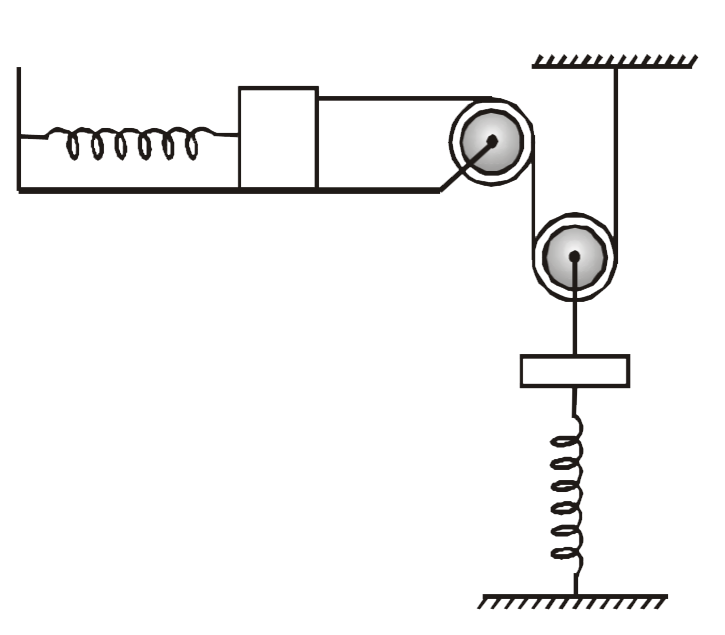
Maximum speed of the block placed horizontally is:08:56View SolutionAs shown in the figure, a uniform sphere is rolling on a horizontal surface without slipping, under the action of a horizontal force F.

Statement - 1 : Power developed due to friction force is zero. Statement -
2 : Power developed by gravity force is non- zero.02:34View SolutionStatement - 1 : Sum of work done by the Newton’s 3rd law pair internal forces, acting between two particles may be zero. Statement -
2 : If two particles undergo same displacement then work done by Newton’s 3rd law pair forces on them is of opposite sign and equal magnitude.02:04View SolutionStatement - 1: A particle moves along a straight line with constant velocity. Now a constant non-zero force is applied on the particle in direction opposite to its initial velocity. After the force is applied, the net work done by this force may be zero in certain time intervals. Statement - 2 : The work done by a force acting on a particle is zero in any time interval if the force is always perpendicular to velocity of the particle.
03:17View SolutionA rifle man, who together with his rifle has a mass of `100 kg,` stands on a smooth surface and fires `10` shots horizontally. Each bullet. has a mass `10 g` and a muzzle velocity of `800 m//s`,
a. What velocity does the rifle man acquire at the end of `10` shots?
b. If the shots are fired in `10 s`, what will he the average force exerted on him?
c. Compare his kinetic energy with that of `10` bullets07:18View SolutionA bullet of mass 10 g travelling horizontally with a velocity of 300 m/s strikes a block of wood of mass 290 g which rests on a rough horizontal floor. After impact the block and the bullet move together and come to rest when the block has travelled a distance of 15 m. The coefficient of friction between the block and the floor will be - (Duration of impact is very short)
05:40View SolutionA `20 g` bullet pierces through a plate of mass `M_(1) = 1 kg` and then comes to rest inside a second plate of mass `M_(2) = 2.98 kg` as shown in Fig. It is found that the two plates, initially at rest, now move with equal velocities. Find the percentage loss in the initial velocity of the bullet when it is between `M_(1)` and `M_(2`. Neglect any loss of material of the plates due to the action of bullet.
 08:08View Solution
08:08View SolutionA bullet of mass 20 g hits a block of mass 1.98 kg suspended from a massless string of length 100 cm and sticks to it. The bullet flies down at an angle of 30º to the horizontal with a velocity of 200 m/s. Through what height the block will rise-
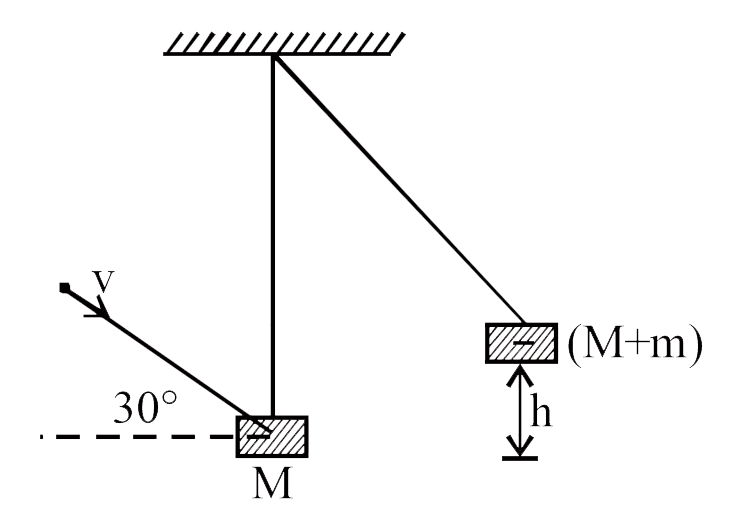 05:28View Solution
05:28View SolutionA bullet of mass 0.01 kg travelling at a speed of 500 m/s strikes a block of mass 2 kg, which is suspended by a string of length 5 m. The centre of gravity of the block is found to rise a vertical distance of 0.1 m. The speed of the bullet after it emerges from the block will be -
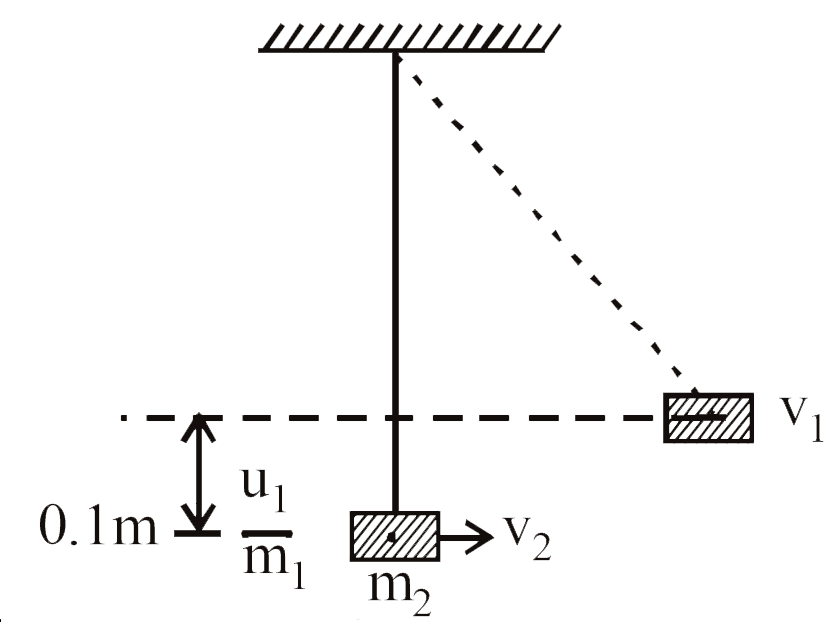 04:11View Solution
04:11View SolutionThe rate of burning of fuel in a rocket is 50 gm/sec. and comes out with and velocity `4 xx 10^(3)` m/s. The force exerted by gas on rocket will be -
02:27View SolutionA body of mass 1 kg strikes elastically with another body at rest and continues to move in the same direction with one fourth of its initial velocity. The mass of the other bodyis-
04:54View SolutionA ball moving with a speed of `9m//s` strikes an identical ball at rest, such that after the collision, the direction of each ball makes an angle of `30^(@)` with the original line of motion. Find the speeds of the two balls after collision.
05:41View SolutionThe mass of a rocket is 500 kg and the relative velocity of the gases ejecting from it is 250 m/s with respect to the rocket. The rate of burning of the fuel in order to give the rocket an initial acceleration `20 m//s^(2)` in the vertically upward direction `g = 10 m/s^(2)`, will be -
03:58View SolutionA slow moving electron collides elastically with a hydrogen atom at rest. The initial and final motions are along the same straight line. What fraction of electron's kinetic energy is transferred to the hydrogen atom? The mass of hydrogen atom is 1850 times the mass of electron.
05:14View SolutionA particle of mass 4 m which is at rest explodes into three fragments. Two of the fragments each of mass m are found to move with a speed v each in mutually perpendicular directions. The total energy released in the process of explosion is ............
04:47View SolutionA body of mass M splits into two parts aM and `(1-alpha)` M by an internal explosion, which generates kinetic energy T. After explosion if the two parts move in the same direction as before, their relative speed will be -
05:13View SolutionA body of mass `1 kg`, initially at rest, explodes and breaks into three fragments of masses in the ratio `1:1:3`. The two pieces of equal mass fly off perpendicular to each other with a speed of `30 m//s` each. What is the velocity of the heavier fragment?
02:02View SolutionA body of mass `m` moving with a velocity `v` in the `x` direction collides with another body of mass `M` moving in `y` direction with a velocity `V`. They coalesce into one body during collision.
10:18View SolutionA ball of a mass m hits the floor with as speed v making an angle of incidence `theta` with the normal. The coefficient of restitution is e. Find the speed of the reflected ball and the angle of reflection of the ball.
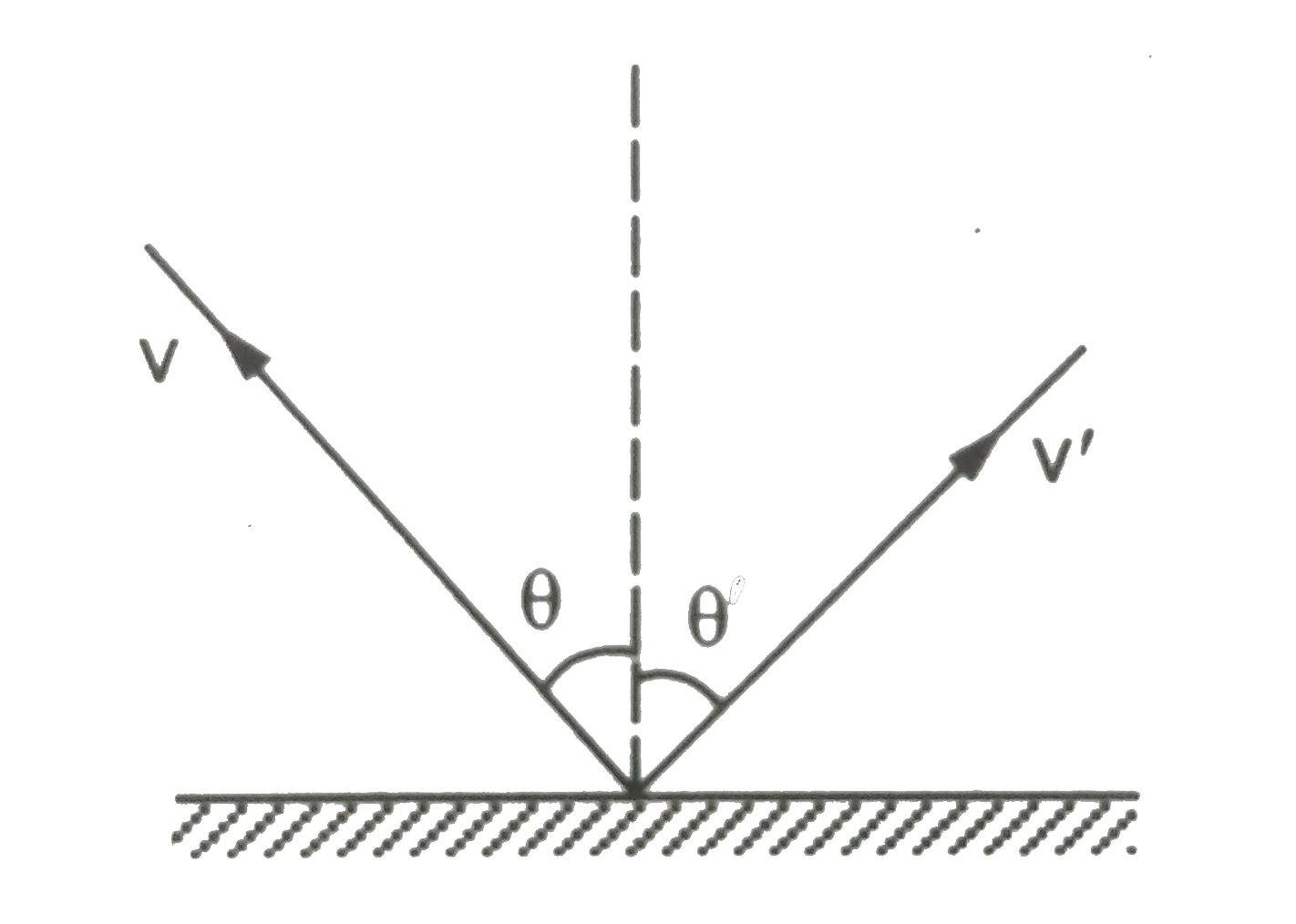 `06:41View Solution
`06:41View SolutionA tennis ball dropped from a height of 2 m rebounds only 1.5 metre after hitting the ground. What fraction of energy is lost in the impact?
03:14View SolutionA bullet is fired from the gun. The gun recoils, the kinetic energy of the recoil shall be-
01:38View SolutionPrinciple of conservation of linear momentum is duduced from
03:07View SolutionDuring inelastic collision between two bodies, which of the following quantities always remain conserved ?
01:39View SolutionInelastic collision is the-
02:06View SolutionWhich of the following statements is false for collisions-
(1)Momentum is conserved in elastic collisions but not in inelastic collisions.
(2)Total-kinetic energy is conserved in elastic collisions but momentum is not conserved.
(3)Total kinetic energy and momentum both are conserved in all types of collisions
(4)Total kinetic energy is not conserved in inelastic collisions but momentum is conserved03:35View SolutionTwo balls of mass `m_(1)` and `m_(2)` where `m_(2)=0.5m_(1)`, undergo head on collision as shown in figue.
_2019_CBT2_E01_005_Q01.png)
After collision the situation is as shown
_2019_CBT2_E01_005_Q02.png)
If `V_(3)=0.5v_(1)`. Value of `V_(4)` is03:24View SolutionTwo balls at the same temperature collide inelastically. Which of the following is not conserved?
(1) Kinetic energy
(2) Velocity
(3) Temperature
(4) Momentum01:24View SolutionA small particle of mass `m = 2 kg` moving with constant horizontal velocity `u = 10 m//s` strikes a wedge shaped block of mass `M = 4 kg` placed on smooth horizontal surface on its inclined surface as shown in figure. After collision particle starts moving up the inclined plane. Calculate the velocity of wedge immediately after collision.
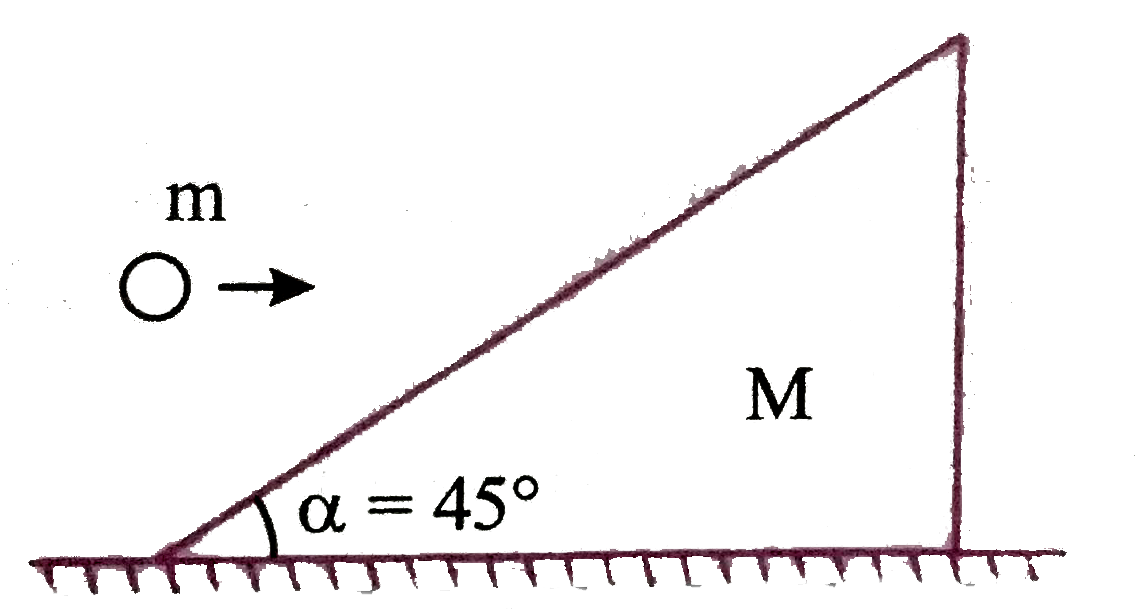 05:17View Solution
05:17View SolutionA small particle of mass `m = 2 kg` moving with constant horizontal velocity `u = 10 m//s` strikes a wedge shaped block of mass `M = 4 kg` placed on smooth horizontal surface on its inclined surface as shown in figure. After collision particle starts moving up the inclined plane. Calculate the velocity of wedge immediately after collision.
 05:17View Solution
05:17View SolutionA sphere of mass `m` and radius `r` rolls without slipping on the horizontal surface with speed `v`. During its motion it encounters a fixed rectangular block of height `h=(r )/(4)` as shown. The collision is inelastic. Find the angular speed of sphere immediately after collision. The body rolls without slipping.
07:15View SolutionA particle of mass m strikes a wedge of mass M horizontally as shown in the figure.

Statement - 1 : If collision is perfectly inelastic then, it can be concluded that the particle sticks to the wedge.
Statement - 2 : In perfectly inelastic collision velocity of both bodies is same along common normal just after collision.02:52View SolutionIn an elastic collision between two particles
01:49View Solution
physics questions and complete solutions for chapter WORK, ENERGY AND POWER of DISHA PHYSICS (HINGLISH) of Class 12
